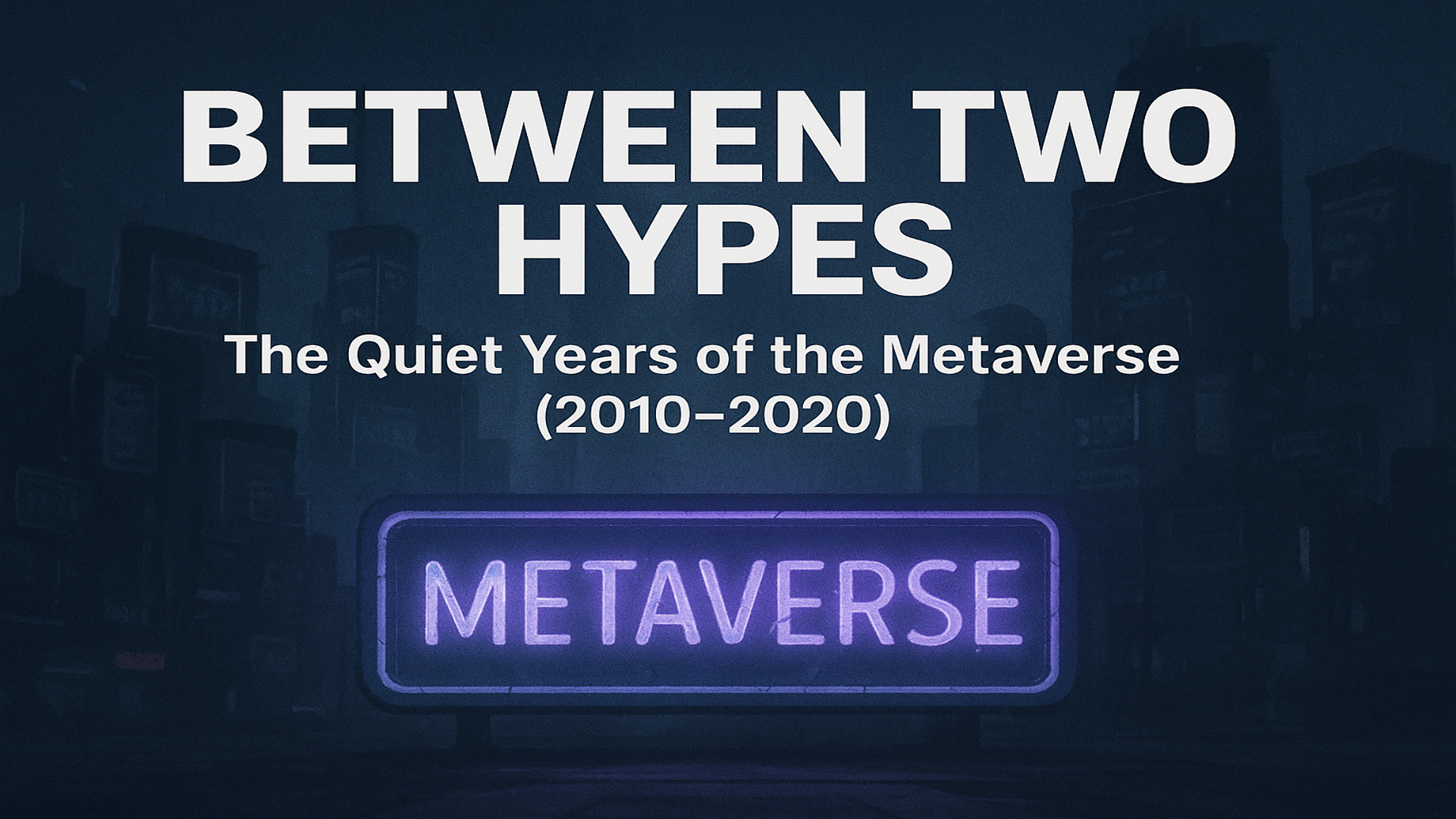The Metaverse Series - Article 04

Between Two Hypes: The Quiet Years of the Metaverse (2010–2020)
How a decade of decline, reinvention, and decentralization kept the Metaverse dream alive, just out of view
After the dizzying rise and slow fade of Second Life in the late 2000s, the Metaverse entered what felt like a long winter. The hype had cooled. The headlines disappeared. Most of the public moved on.
But even as attention shifted toward mobile apps, social media, and the cloud, a small but dedicated group of developers, researchers, and digital idealists kept building. In forgotten forums and niche platforms, the idea of persistent virtual worlds persisted. This decade didn’t produce another media phenomenon, but it laid the groundwork for the Metaverse’s next big evolution.
This was the era of quiet reinvention.
The Long Tail of Second Life
By 2010, Second Life was no longer a cultural sensation. Its user base had plateaued, the media had moved on, and Linden Lab began pivoting toward smaller projects. Yet Second Life never actually died. It kept running and continues to this day. A core group of creators and communities maintained its virtual economy, its events, and even its cultural identity.
But it was clear the platform had reached a ceiling. Its codebase was aging, its UI increasingly outdated, and the technical barriers (hardware requirements, lag, complex tools, poor scalability) and cultural barriers (unclear purpose, fragmented communities, negative media framing, and safety issues) that had once been ignored during the boom years were now glaringly obvious. New users struggled to find relevance in a platform that hadn’t evolved with the times.
Many in the community began looking elsewhere.
OpenSim and the Promise of Federation
Enter OpenSimulator, commonly known as OpenSim, an open-source virtual world platform compatible with Second Life clients and protocols. Launched in the late 2000s and gaining traction through the 2010s, OpenSim offered something Second Life never did: control.
Anyone could spin up their own grid, create their own regions, and set their own rules. OpenSim promised freedom; freedom from Linden Lab’s centralization, freedom from platform fees, and freedom to interconnect independent virtual worlds in a federated model.
On paper, it was the logical next step for the Metaverse. Instead of one giant world, there could be many interoperable ones. Users could host their own space but still travel across the network, an early vision of decentralization that mirrored later Web3 ideals.
But OpenSim never achieved critical mass. It remained mostly in the hands of educators, researchers, and tech-savvy hobbyists. The experience was fragmented, support varied wildly, and the technical barriers were still high. While the vision was bold, the execution struggled with usability and mainstream appeal.
Kitely, High Fidelity, and Niche Reinventions
In the years that followed, other platforms emerged with the aim of modernizing the Metaverse experience. Notable among them was Kitely, a grid built on OpenSim with a cloud-based model, offering scalable, affordable regions on demand. Kitely tried to strike a balance between user control and ease of access, adding features like a marketplace and social tools.
Meanwhile, High Fidelity, founded by Second Life creator Philip Rosedale in 2013, took a different approach, by betting on spatial audio, VR support, and decentralized hosting. It hoped to build a next-generation, immersive communication platform that could replace video calls with rich, 3D interaction.
Both platforms had innovative ideas, and both failed to gain wide traction.
There were many reasons: lack of user-friendly onboarding, niche target audiences, an unclear purpose beyond novelty, and the ever-present challenge of building sustainable, active communities from scratch. The Metaverse, it seemed, remained a solution in search of a problem.
The Cultural Shift: From Worlds to Platforms
During the 2010s, consumer culture began favoring more accessible, lightweight digital experiences. People wanted mobile apps and instant interactions, not sprawling virtual spaces that required downloads, learning curves, and commitment.
This shift gave rise to platforms like Roblox, Minecraft, and VRChat, each capturing parts of the original Metaverse idea, but wrapped in a more accessible, gamified, or social format.
-
Minecraft became the most successful sandbox world-builder ever, with millions using it as a space for play, education, and creativity.
-
Roblox enabled a generation of kids to create games, socialize, and even earn money within a structured, mobile-friendly environment.
-
VRChat allowed for highly expressive social interaction in VR, reviving the avatar-driven social culture of Second Life in a new medium.
These platforms didn’t identify as “Metaverse” projects at the time, but they carried the DNA forward in new directions.
The Web3 Spark: A New Vision for Ownership
Toward the end of the 2010s, a new concept began to emerge: Web3. This new internet paradigm focused on decentralization, user ownership, and blockchain-based technologies. Suddenly, the problems that had plagued previous virtual worlds, such as centralized control, lack of interoperability, and fragile digital economies, seemed solvable.
Projects like Decentraland, Cryptovoxels, and Somnium Space emerged from this movement. Built on blockchain infrastructure, these platforms allowed users to own virtual land, objects, and identities on-chain, in wallets they controlled. Digital property became tokenized. Marketplace transactions were secured via smart contracts.
It was the beginning of a new kind of Metaverse hype: one powered by Web3 ideals of decentralization and scarcity.
However, this new approach didn’t solve the old problems, such as a steep learning curve, low technical quality, lack of clear purpose, overpromised returns, as well as poor moderation and safety. Many new and more complex ones would arise, but it reinjected energy into a space that had been quietly surviving for years.
A Decade of Foundations
While the 2010s may be remembered as a “lost decade” for the Metaverse in popular culture, it was anything but inactive. It was a time of:
-
Technological experimentation: Cloud hosting, VR, spatial audio, open protocols
-
Philosophical refinement: Ownership, decentralization, privacy, identity
-
Cultural migration: From dedicated virtual worlds to embedded platforms (Minecraft, VRChat)
-
Community building: Small, tight-knit communities that kept the vision alive
Most importantly, it was a decade in which the Metaverse matured away from media hype and toward something more thoughtful, albeit still searching for its breakthrough moment.
Looking Ahead
As the 2020s began, a perfect storm was brewing: advances in VR hardware, renewed investor interest, the COVID-19 pandemic driving demand for digital presence and the rise of crypto-fueled enthusiasm for digital property.
In the next article, we’ll explore this second Metaverse boom, with Meta (formerly Facebook), NFTs, and the Web3 explosion and how once again, old dreams returned in a new skin.
But we’ll also ask: Did anybody learn anything from the last time?
Join the Conversation
If this article sparked your curiosity or passion for the future of the Metaverse, I warmly invite you to join an open discussion in a virtual world setting. Let’s meet face-to-face (or avatar-to-avatar) to exchange ideas, share visions, and connect with others who believe in building something better. The next live meetup will take place on the 26th of September at 9 p.m. (UTC+2) in our Metaverse Meeting Point. Whether you’re a developer, creator, thinker, or explorer, your perspective matters. Come help shape the next chapter of the Metaverse!
.png)
About the Author
Dieter E. Heyne is a Metaverse pioneer and lifelong technologist, born in Munich in 1966. With a master’s degree in applied computer science and over three decades of experience as an IT entrepreneur, software architect, and consultant, he has always been at the frontier of digital innovation. His journey into virtual worlds began in 2007 with Second Life and sparked a deep, ongoing exploration of the Metaverse as a space for education, collaboration, and immersive experiences.
Since 2012, Dieter has been developing and refining a web-based virtual world platform, driven by a vision to make the Metaverse accessible, meaningful, and transformative. As a frequent speaker and thought leader at Metaverse events, he shares his insights on how virtual environments can reshape human interaction, learning, and culture. He is the founder and CEO of Metaverse School GmbH, a company dedicated to promoting Metaverse literacy and helping people and organizations understand the power and promise of these emerging digital realms.
About Metaverse School GmbH
Metaverse School GmbH was founded in 2017 by Dieter E. Heyne, who continues to lead the company as its CEO. The company emerged from decades of consulting experience in software architecture, project management, quality assurance, information security, and data protection. Building on this strong technological foundation, Metaverse School GmbH is dedicated to promoting the responsible and purposeful use of immersive 3D environments—for education, collaboration, training, and simulation.
A core mission of the company is to raise awareness of the Metaverse’s potential across business, education, and society. In support of this goal, Dieter Heyne regularly speaks at national and international conferences as well as Metaverse-focused events. Through real-world examples and deep expertise, he demonstrates how immersive technologies can already create meaningful value today.
Disclaimer
Some portions of this content were created or refined with the assistance of artificial intelligence (AI) using tools such as OpenAI’s ChatGPT. The ideas, structure, and editorial direction remain the responsibility of the author. While every effort has been made to ensure factual accuracy and original expression, readers are encouraged to approach speculative or future-facing statements with critical thought.
This series does not represent the views of any specific company or platform and is intended to inspire open discussion around the evolving concept of the Metaverse.
 METAVERSE BLOG
METAVERSE BLOG